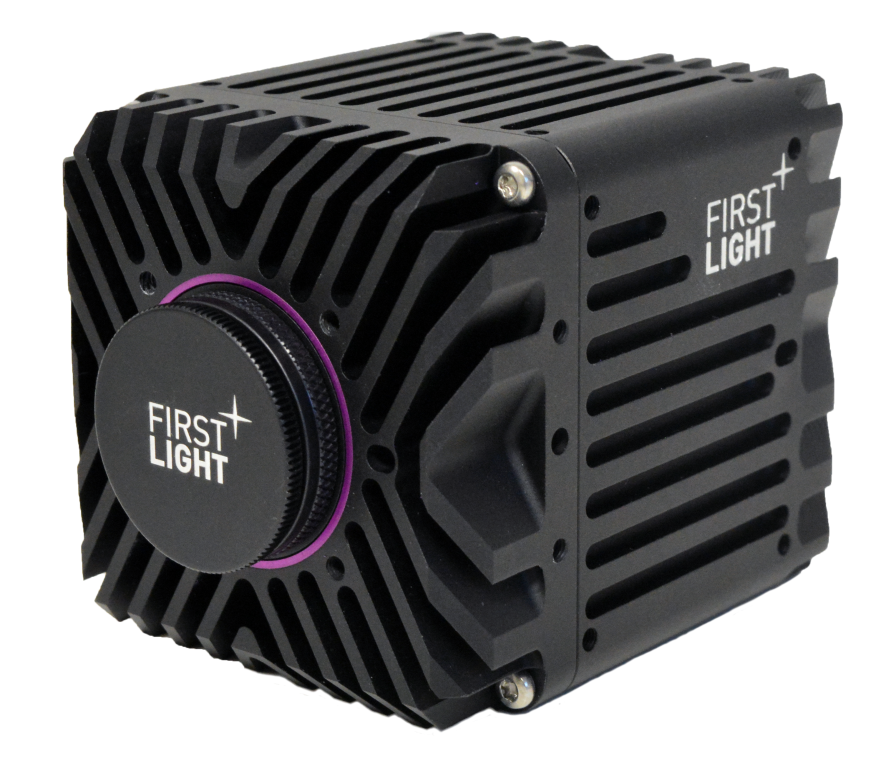C-RED 2 Lite is a 640 x 512 stabilized SWIR camera running at 600 FPS full frame.
Recent experiments have demonstrated that radiometric temperature measurements are possible with this camera. A specific plugin in our First Light Vision software enables to calibrate an imaging system and perform non-contact thermography.
1. WHAT IS THERMOGRAPHY?
All materials at a temperature above 0 K (-273.15°C) radiate energy. By measuring the emitted radiation with prior knowledge of spectral range and emissivity, the temperature of an object can be retrieved. Thermography is the technique used to make such temperature measurements. Applications include welding, metal and glass industry, etc.
Planck’s law describes the spectral distribution of the radiation emitted by a black body, when there is no flow of matter or energy between the body and its environment [1].
The intensity and spectral distribution of the emitted radiation are function of the temperature and the surface emissivity of the hot body. The higher the temperature of a body, the more radiation it emits at every wavelength.
Black body radiance. Planck’s law gives the theoretical radiance as a function of wavelength.
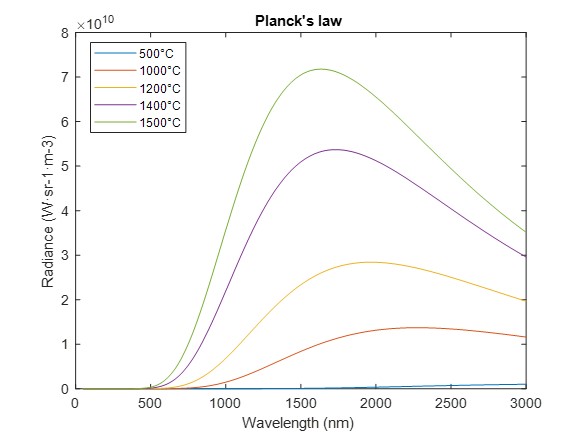
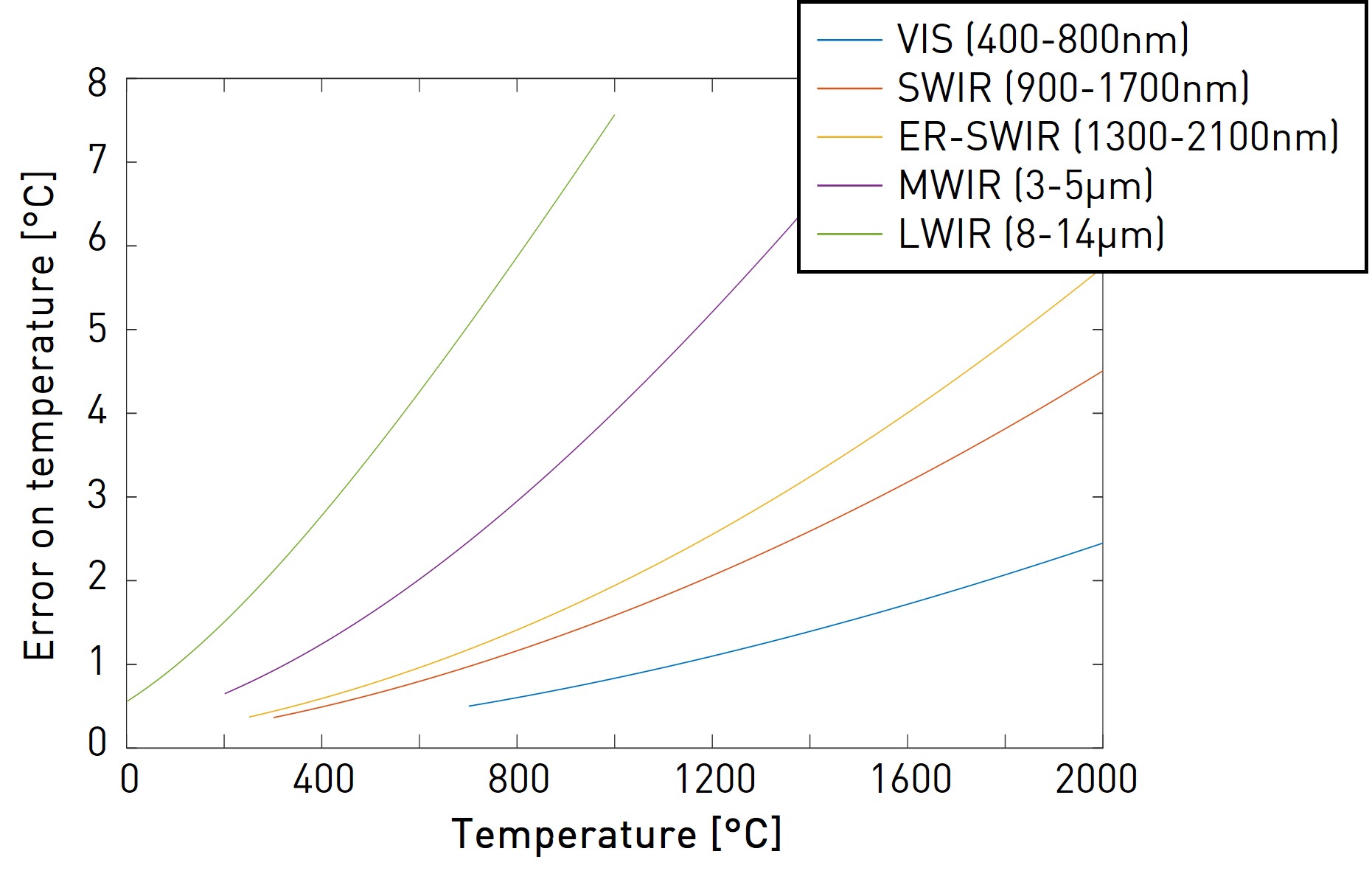
Why choosing the SWIR range?
The infrared spectrum can be divided into three bands : SWIR (900-1700 nm), MWIR (3-5 µm) and LWIR (7-14 µm). For temperature measurements within 300 – 1600 °C there is a real advantage of working in the SWIR range. It optimizes the spectral radiance and diminishes the error induced by emissivity, thus optimizing the measurement precision. As a general rule: the measurement error is higher for higher temperatures at longer wavelengths.
| SWIR cameras can be used to perform temperature measurements in the range of 300 to 1600°C with a high accuracy |
2. WHY USE C-RED 2 LITE ?
In the C-RED 2 Lite camera, the sensor is stabilized by a thermo-electric cooler (TEC) and integrated in a compact and robust high-speed SWIR camera.
Thanks to a new plugin in the First Light Vision software, C-RED 2 Lite can be used for radiometrically calibrated thermography imaging!
| Thermography module First Light Vision provides everything you need to set up, control, display and record thermography images.
|
- SWIR range. C-RED 2 Lite has a > 70% quantum efficiency from 900 nm to 1700 nm. This enables precise thermal measurement from 300°C to 1600 °C.
- High sensitivity. C-RED 2 Lite compensates the dark current by a very high frame rate. In full frame (640 x 512 pixels) the camera can run at 600 fps. When used in windowing (ROI) mode at higher frame rates (up to 32 066 fps), the dark current is completely negligible. Additionally, dark frame corrections are performed on-the-fly in the camera without loss of framerate.
- Easy integration. C-RED 2 Lite can be easily integrated in your system thanks to numerous drilled holes and has a C-Mount/CS-Mount optical interface. C-RED 2 Lite is supported by our multi-camera software First Light Vision. And thanks to a versatile SDK, the camera can be interfaced with MatLab, LabView, Python, etc.
- Antiblooming. This feature prevents pixels with excessive charge to bleed off on its neighbors and corrupt the image. It is an essential asset when imaging high dynamic signals.
- Large dynamic. The three integration capacitors (high, medium and low) enable tuning the conversion gain (from electrons to ADUs). While high gain will enhance sensitivity, low gain optimizes full well capacity.
- High Dynamic Range mode. Due to the non-linear relationship between the radiation emitted by an object and its temperature, it is required that the camera has a very high dynamic. In HDR mode, the signal from the high and low capacities are linearly combined, allowing the camera to reach a dynamic of 93.6 dB while maintaining the high framerate.
3. PROOF OF CONCEPT OF SWIR THERMOGRAPHY
A camera will detect the radiance emitted by objects. Interestingly, the radiance is a known function of temperature. Hence, the camera output in Arbitrary Digital Units (ADU) – grey levels – can be converted to temperature.
Radiance as a function of temperature
By integrating Planck’s law over the wavelengths 900 to 1700 nm it is possible to obtain the theoretical total SWIR radiance as a function of temperature. It is valid for a black body (idealized object which absorbs and emits all radiation frequencies).
The radiance that can be detected by a thermography device is a fraction of this total radiance and depends on the optics (aperture, transmission) and the detector (quantum efficiency).
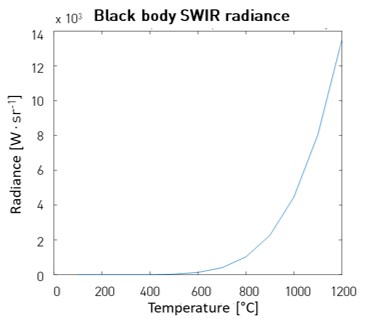
Black body SWIR radiance. The integration of Planck’s law in the SWIR range gives the theoretical detectable radiance.
Material and methods
A thermography device needs to be calibrated to adjust the relationship between temperature and detected radiance.
In this experiment a RN1350 N1 black body from HGH Infrared is used. The temperature of the black body can be tuned within a 50 to 1350°C range. The imaging system is a First Light Imaging camera with a 35 mm SWIR objective.
The environment temperature is stable and measurements are made in a black box.
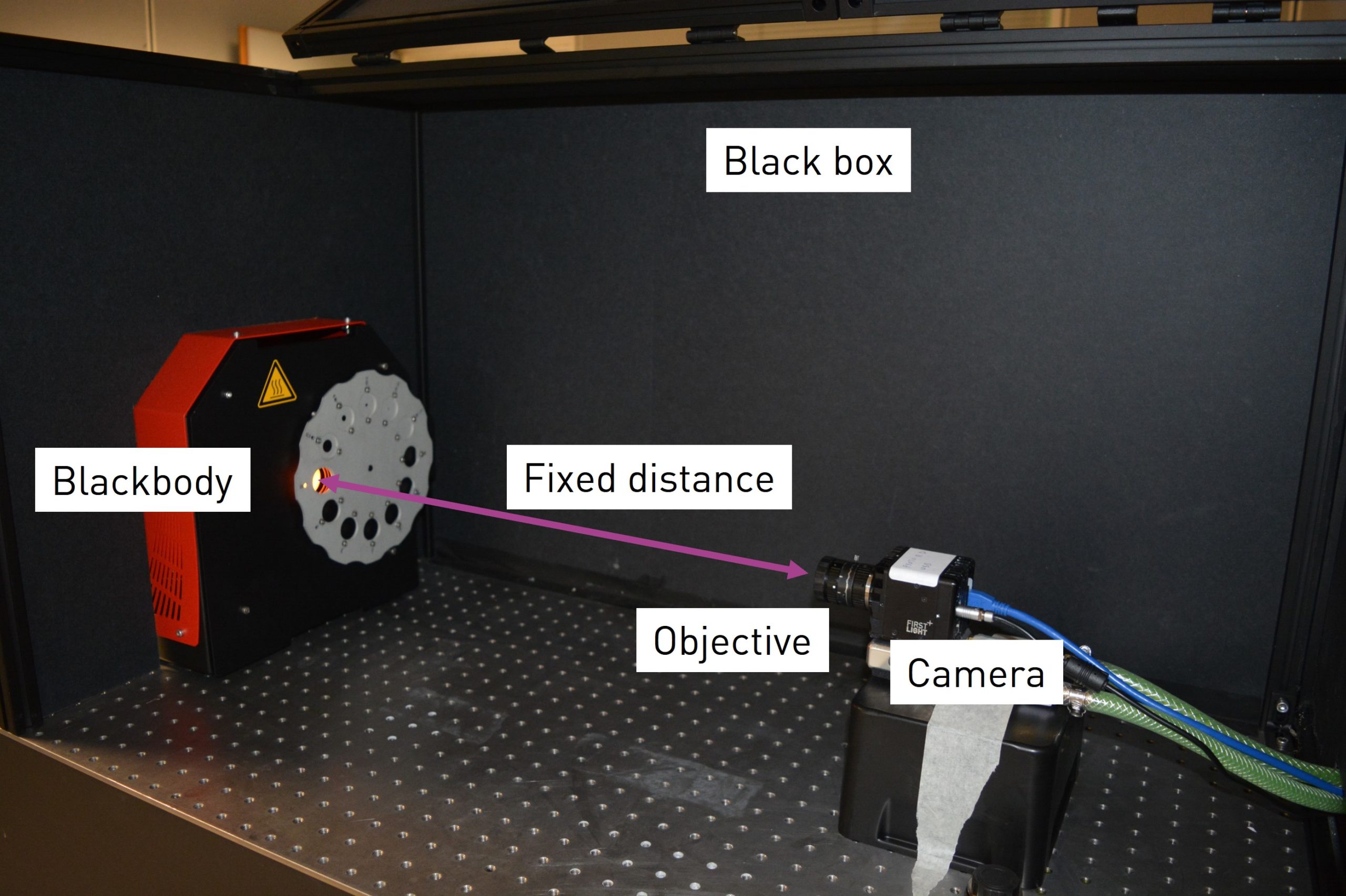
Thermography calibration bench.
Detected radiance as a function of temperature
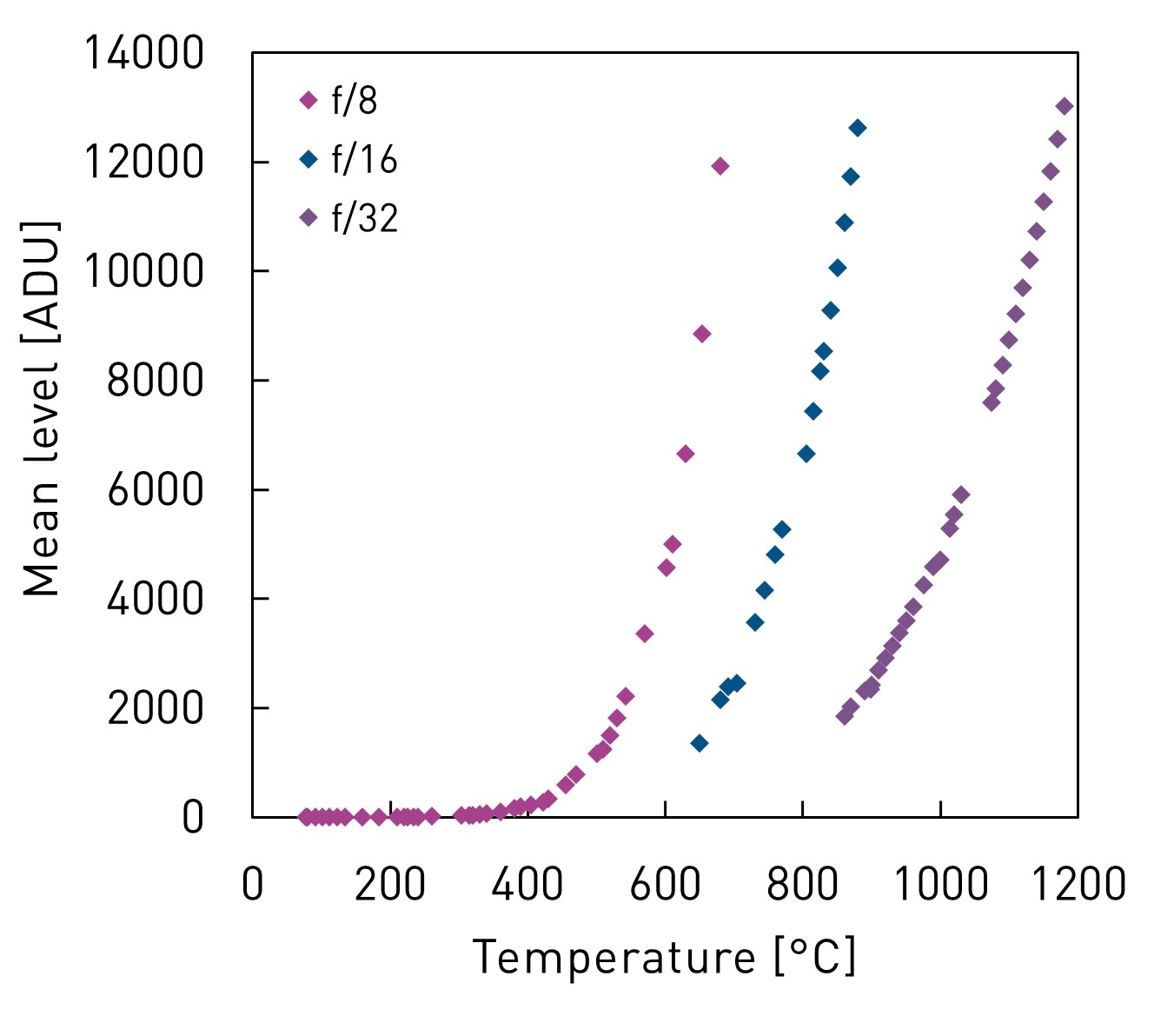
Experimental results. The three sets of data correspond to different apertures of the objective lens.
A homogeneous region of interest in the center of the black body is used to evaluate the detected radiance, in units of ADU. When the detector saturates, the aperture of the objective lens is shut by one f-stop.
The acquisition parameters are the following :
- Framerate : 600 FPS
- Integration time : 0.2 ms
- Corrections : bias subtraction and bad pixel correction
- Numerical aperture : f/8, f/16 and f/32
For each temperature point (every 10°C), the mean detected level is plotted against temperature.
Fit of experimental data to theory
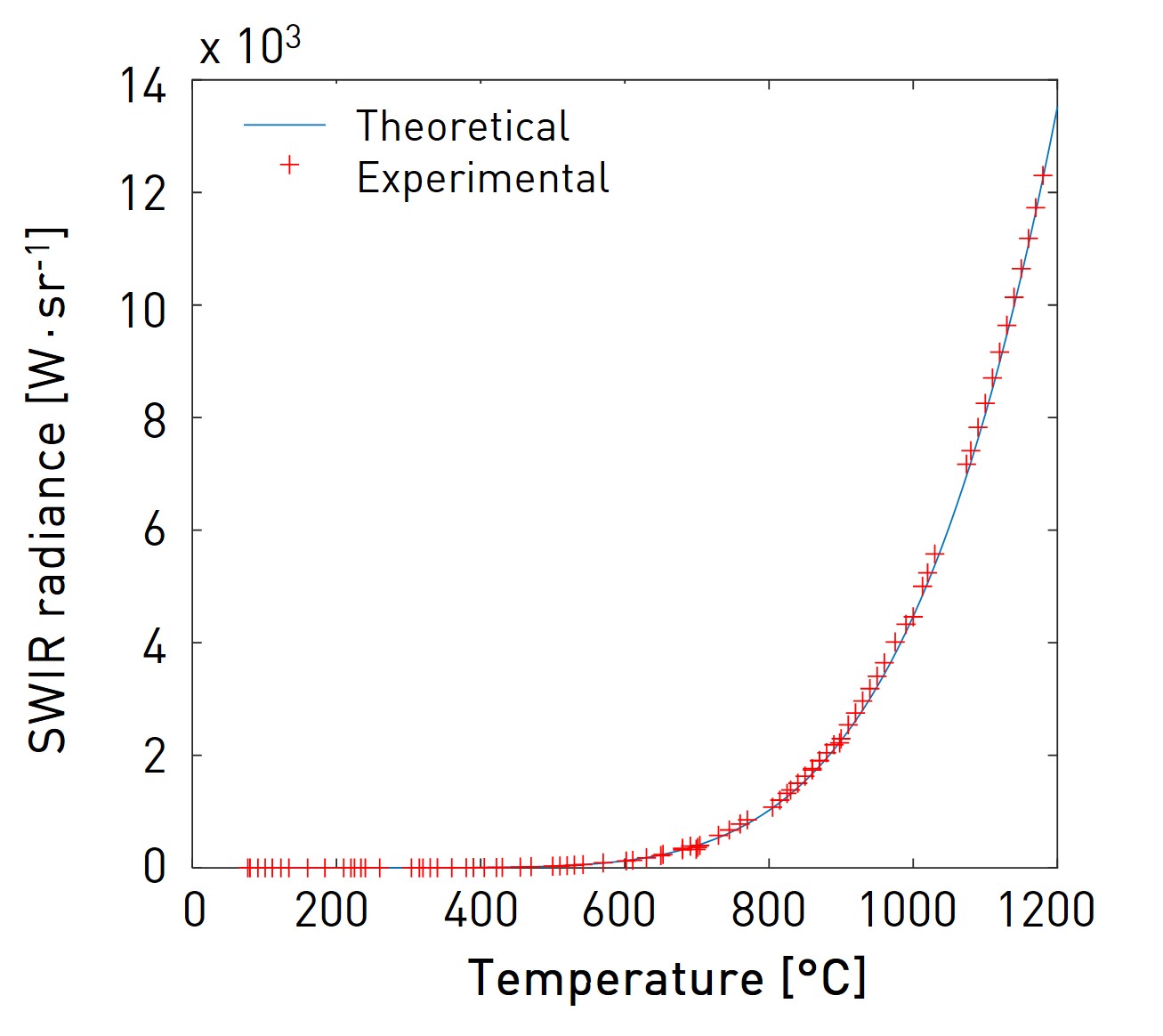
Fit of the experimental results (red crosses) to the theoretical model (blue line).
The experimental data sets can be fitted on the theoretical SWIR radiance as a function of the temperature curve described earlier.
The multiplication coefficient used is the ratio of the radiance emitted by the blackbody to the radiance detected by the sensor (expressed in W⋅sr-1 per ADU). It depends on the entire thermography device : the objective lens (aperture, transmittance), the camera (quantum efficiency, conversion gain, etc.), the distance from the object to the device and the object’s emissivity. Hence, each of the data set (f/8, f/16 and f/32) will have a specific conversion factor to convert ADUs to SWIR radiance.
The calibration of the thermography device consists in finding this conversion factor.
Temperature measurement precision & accuracy
There are several aspects to consider :
- Due to the non-linear relation between temperature and radiance: in a given configuration, the higher the temperatures, the higher the measurement precision.
- The thermography system final precision depends on both the camera and the optics (aperture, magnification, etc.)
- The main camera parameter to consider to optimize the precision is the total dark noise and dark signal stability over time.
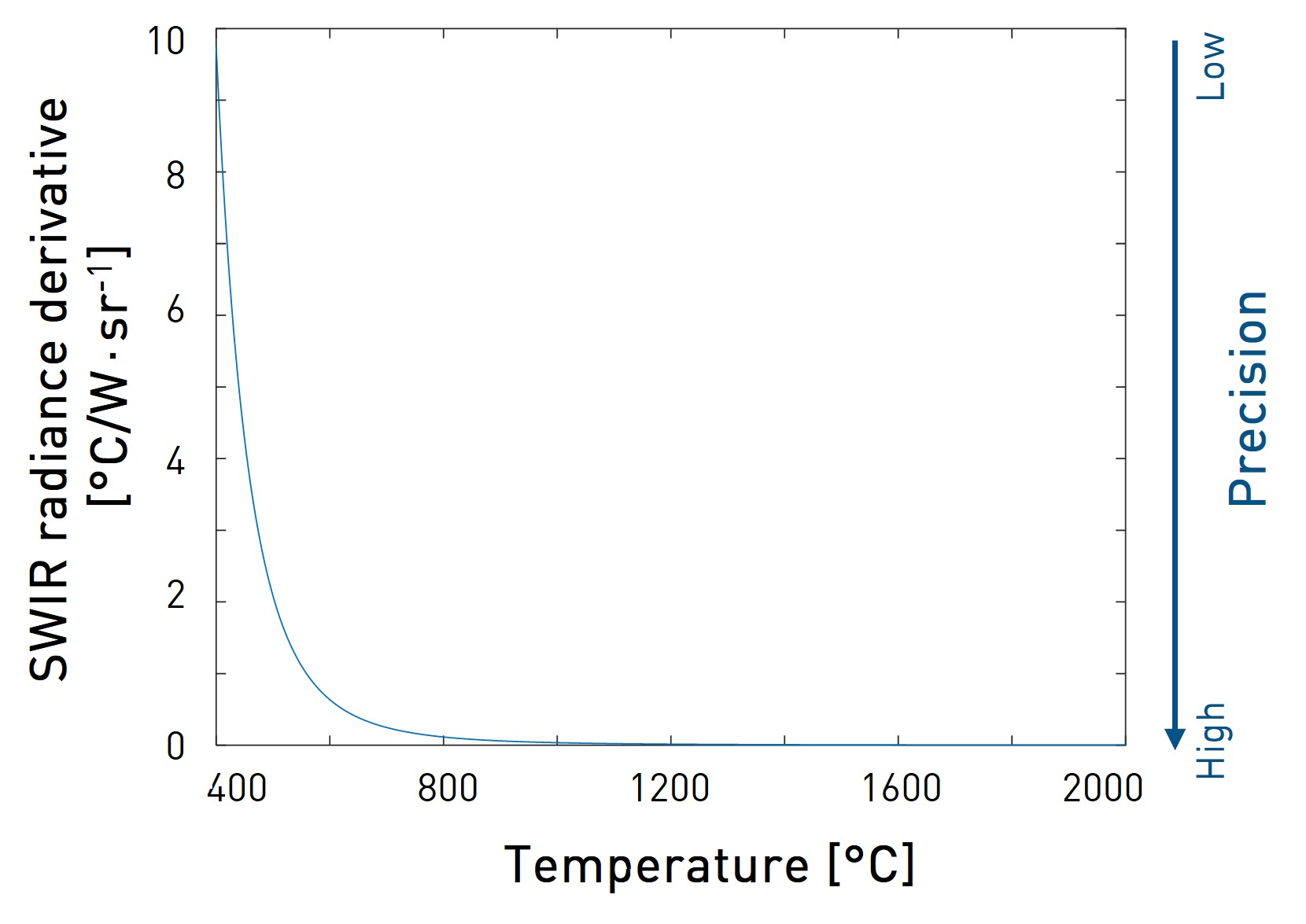
Theoretical precision of SWIR black body radiance measurement.
To optimize the accuracy of the temperature measurement,
- Environmental factors (temperature, humidity, atmospheric conditions, dust, etc.) should be stable.
- The camera performance, especially dark signal, should be known and stable over time.
- The distance between the thermography device and the object should be constant.
- The calibration of the thermography device should be performed with a high quality black body source.
Some sources of inaccuracy may be difficult to mitigate but should not be overlooked:
- Objects with low emissivity often have a high radiation reflection, resulting in temperature measurement errors due to background reflection.
- An error on the evaluation of the emissivity of the object will result in an error on the temperature measurement. Emissivity is dependent on various parameters (wavelength range, surface state) and should be evaluated precisely. The use of a spectral range filter can reduce the inaccuracy.
|
C-RED 3 is a plug-and-play SWIR camera. |
4. USE CASES
With a calibrated thermography system, it is possible to perform radiometric measurements. Non-contact thermography can be used for numerous applications. Some examples are shown below.
Monitoring industrial processes
- In the glass industry the different stages (melting, forming, etc…) need to be monitored. Materials are heated to temperatures in the 500°C to 1000°C range, and the cooling process is monitored.
- In the metal industry, monitoring the cooling phase is crucial to ensure quality, for example during the casting process (when materials are poured into a mold). The process temperature is around 1250°C to 1600°C.
- Additive manufacturing is used to repair or manufacture functional parts (g. for the aerospace industry). For example, temperatures at stake in the case of laser additive manufacturing of steel are in the order of 500°C to 1400°C. See our video: “Application : Wire Arc Additive Manufacturing”.
Screenshot of First Light Vision software in thermography mode
Equipment maintenance
In other industries, thermography can be used to control equipment : hot spots, leaks, cracks, etc.
Using a camera combined to First Light Vision’s thermography module, a movie was shot to study the heating process of an old electrical resistance. The temperature map points out the spatial temperature inhomogeneities and local defects of the surface.
Time-lapse of a resistance heating up.
5. CONCLUSION
C-RED 2 Lite is a high performance camera designed for short wave infrared applications. The camera can reach 600 FPS in full frame. Thanks to this, C-RED 2 Lite is very flexible and can be used for a large scope of applications !
The infrared radiation of a body can be used to measure its temperature. A thermography system comprises an objective lens, a camera, and specific computing capability to convert the signal to temperature. First Light Vision’s thermography module enables calibration of specific experimental designs.
First Light Imaging’s thermography solution comprises a camera * and the First Light Vision software **
Non-contact temperature measurements have endless applications such as detection of temperature irregularities, non-destructive process monitoring in the glass industry, maintenance of machines in the metal industry (overheating, hot spot detection, etc.), etc. C-RED 2 Lite further enables to target new applications thanks to its unique 600 FPS full frame! Its very fast response is a key asset for:
- Material science development (thermal stress analysis, laser processes, etc.)
- Studying processes with rapid local temperature changes
- Research on tribology (friction, lubrication, wear) phenomena
For more application ideas, check out our FOCUS ON… series !
FOCUS ON… Free Space Optical communications
FOCUS ON… Monitoring weld deposition
FOCUS ON… High speed hyperspectral imaging, etc !
* The thermography plugin can be used with C-RED 3, C-RED 2 Lite and C-RED 2 cameras.
** First Light Imaging only provides bricks of the full thermography device. As such, First Light Imaging does not guarantee the quantitative performance of the temperature measurement. Additional material is required : an object of known temperature and emissivity to perform the single-point calibration and an objective lens for imaging.
Resources
- Planck, M. The Theory of Heat Radiation, 2nd ed.; P. Blakiston’s Son & Co, 1914.
For more information, (or to share your C-RED 2 Lite images!), feel free to contact us:
First Light Imaging
contact@first-light.fr
www.first-light-imaging.com


